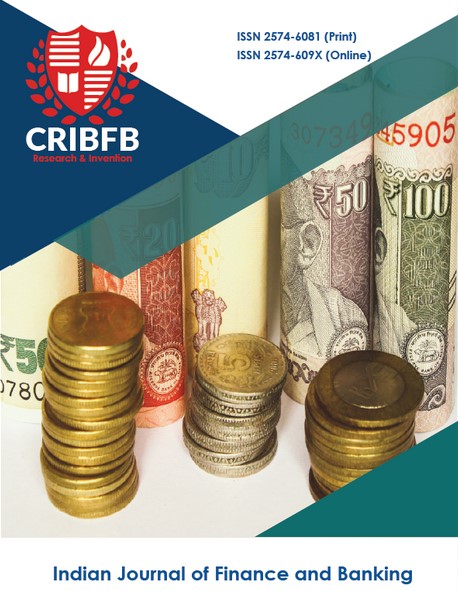Evaluating Rainfall Risk Profile of Indian Subcontinent Based on Index Metrics
Main Article Content
Abstract
Floods and droughts represent an embedded monsoon factor impacting the Indian economy. Evaluating monsoon risk based on rainfall index metrics could help design appropriate alternative risk transfer products. This study proposes a new set of rainfall indices that can be used to explore the excess rainfall risk profile of the Indian Subcontinent. The study proposed a new set of indices for evaluating excess rainfall risk profiles which are defined as Excess Rainfall Days (ERDs). The methodology proceeds in a step-wise form: Empirical values of ERDs over 50 years for selected MSDs of India are derived, and then these index values are analyzed for determining the degree of variability and volatility, followed by the examination of the degree of inter-correlation amongst indices of selected Meteorological Sub-divisions. The research is based on the applications of econometric models such as the Augmented Dickey-Fuller (ADF) test followed by the GARCH model. The results revealed that several of the statistical properties of ERD indices support the idea that these indices could be used as building blocks for designing rainfall derivatives similar to HDDs/CDDs underlying temperature derivatives.
Downloads
Article Details
Section
How to Cite
References
Bollerslev, T. (1986). Generalized autoregressive conditional heteroskedasticity. Journal of econometrics, 31(3), 307-327.https://doi.org/10.1016/0304-4076(86)90063-1
Campbell, S. D., & Diebold, F. X. (2005).Weather forecasting for weather derivatives. Journal of the American Statistical Association, 100(469), 6-16. https://doi.org/10.1198/016214504000001051
Chacko, K., Ranadive, R., Sachdeva, M., Hede, S., Bhati, S. B. B., Nainan, A., & Jagasheth, U. (2018). Economic and Industrial impact of Kerala Floods” Care ratings. Retrieved from http://www.careratings.com/upload/NewsFiles/SplAnalysis/Economic%20and%20Industrial%20Impact%20Kerala.pdf
Cao, M., & Wei, J. (2004). Weather derivatives valuation and market price of weather risk. Journal of Futures Markets: Futures, Options, and Other Derivative Products, 24(11), 1065-1089. https://doi.org/ 10.1002/fut.20122
Dickey, D. A., & Fuller, W. A. (1979). Distribution of the estimators for autoregressive time series with a unit root. Journal of the American statistical association, 74(366a), 427-431.https://doi.org/10.1080/ 01621459.1979.10482531
Dickey, D. A., & Fuller, W. A. (1981). Likelihood ratio statistics for autoregressive time series with a unit root. Econometrica: Journal of the Econometric Society, 1057-1072.https://doi.org/0012-9682(198107)49: 4<1057:LRSFAT>2.0.CO;2-4
Government of India, Central Water Commission. (2019). Water and Related Statistics report 2019. Retrieved from http://www.cwc.gov.in/publications.
IPCC, W. (1995).Climate Change 1995-The science of climate change. Contribution of Working Group I to the Second Assessment Report of the Intergovernmental Panel on Climate Change. JT Houghton et al. Retrieved from https://www.ipcc.ch/site/assets/uploads/2018/06/2nd-assessment-en.pdf
Kotreshwar, G. (2006). Managing monsoon risk in India, why not Monsoon Derivatives?. The ICFAI journal of derivatives markets, 3(3), 76-83.
Kotreshwar, G., & Kanakasabai, M. (2006). Design and pricing of Monsoon Derivatives: A conceptual frame work. In A paper presented at international conference of Asia Pacific Risk & Insurance Association (APRIA).
Kotreshwar, G., & Arunkumar, R. (2006). Monsoon Risk Securitisation: Monsoon Options on Select Met Subdivisions.10th Capital Markets Conference, Indian Institute of Capital Markets Paper.http://dx.doi.org/10.2139/ssrn.962322
Kotreshwar, G., (2015). Securitisation of Rainfall Risk in India: Designing Rainfall Derivative Contracts Based on Standard Metrics. Paper presented in International Conference on Emerging Trends in Finance Accounting, SDM-IMD, Mysuru.
Kumar, K. K., & Parikh, J. (2001). Indian agriculture and climate sensitivity. Global environmental change, 11(2), 147-154. http://dx.doi.org/10.1016/S0959-3780(01)00004-8
Mooley, D. A., & Parthasarathy, B. (1983). Indian summer monsoon and El Nino. Pure and Applied Geophysics, 121(2), 339-352.https://doi.org/10.1007/BF02590143
Mooley, D. A., Parthasarathy, B., Sontakke, N. A., & Munot, A. A. (1981). Annual rain‐water over India, its variability and impact on the economy.Journal of Climatology, 1(2), 167-186.https://doi.org/ 10.1002/joc.3370010206
Parthasarathy, B., Munot, A. A., & Kothawale, D. R. (1994). All-India monthly and seasonal rainfall series: 1871–1993. Theoretical and Applied Climatology, 49(4), 217-224. https://doi.org/10.1007/BF00867461
Shivkumar, D., & Kotrshwar, G. (2013).Trading in weather risk transfer products–Reengineering rainfall indexation. International Journal of Business and Management Invention, 2(11), 33-41.Retrieved from https://www.ijitee.org/download/volume-8-issue-5/
Stoppa, A., & Hess, U. (2003, June). Design and use of weather derivatives in agricultural policies: the case of rainfall index insurance in Morocco. In International Conference “Agricultural Policy Reform and the WTO: Where are we heading”, Capri (Italy).Retrieved from https://pdfs.semanticscholar.org/c35b/55afd4a21f 2ee7d2ecdf5460cca5cbe3514.pdf
Singh, C., Del Rio, C. R., Soundarajan, V., Nath, V. & Shivaranjani, V. (2018). Assessing India’s mounting climate losses to Financial Institutions” Action on Climate today. Retrieved from http://www.indiaenvironmentportal.org.in/files/file/climate-losses-revised.pdf




